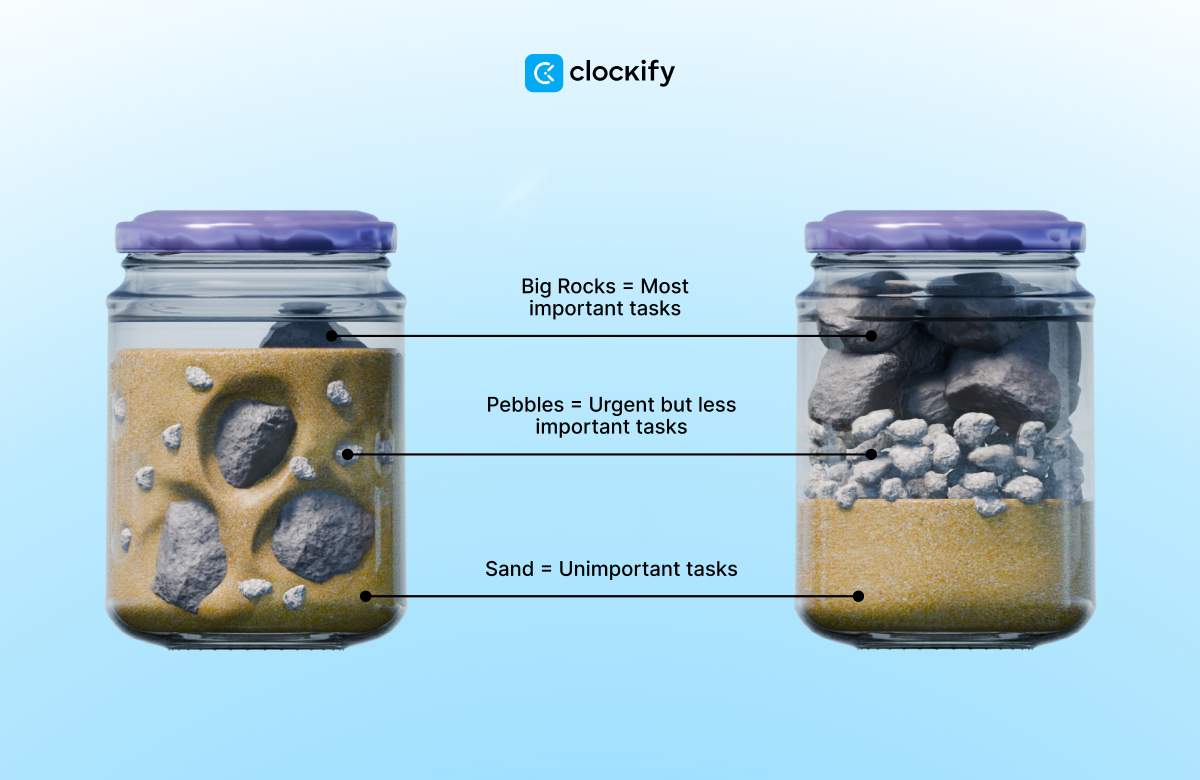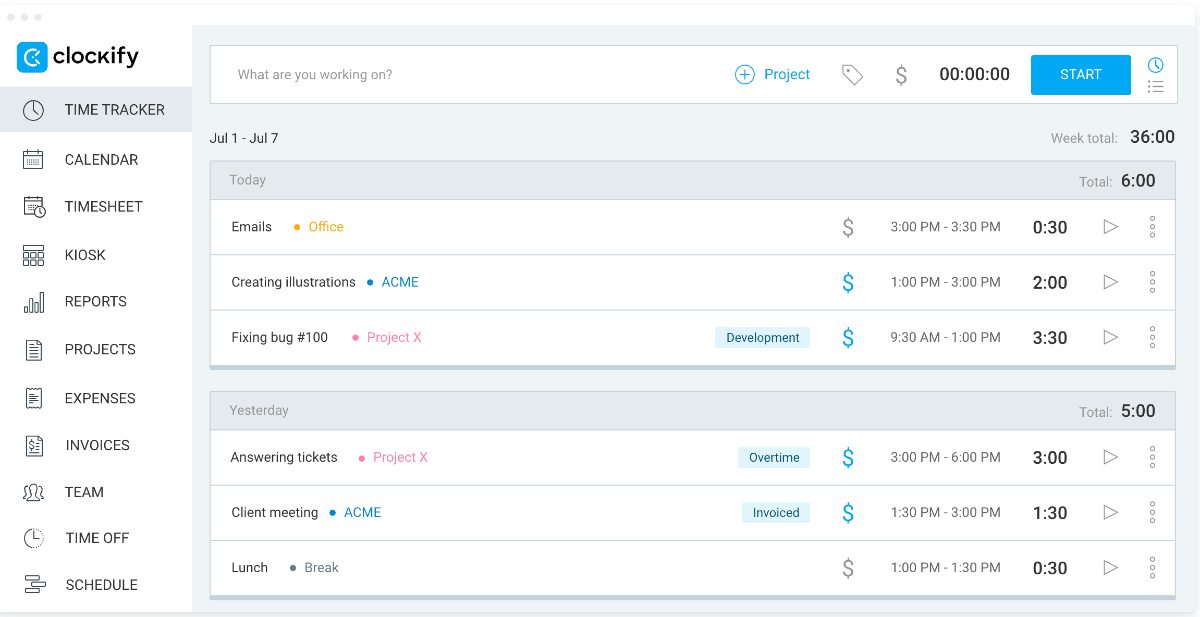Stephen Covey, author of The Seven Habits of Highly Effective People, once said, “If you don’t put the big rocks in first, you’ll never get them in at all.”
Do you sometimes feel like you completed countless activities during a work day, but don’t seem to be productive at the end of the day?
It’s probably because you didn’t prioritize your work accordingly and let insignificant tasks stop you from achieving your ultimate goal.
That’s where the Pickle Jar Theory comes in. In short, it’s based on prioritizing your daily activities while respecting the time estimate for each.
This blog post will help you understand the gist of the Pickle Jar Theory and how to fit it into your daily routine effectively.

Table of Contents
What is the Pickle Jar Theory?
The Pickle Jar Theory is a simple time management technique that helps you focus on what matters most each day — without letting distractions and low-priority tasks take over. It’s also known as the Bucket of Rocks Theory or the Jar of Life Theory.
Interestingly, the Pickle Jar Theory was developed in 2002 by Jeremy Wright, who proposed that time is a finite space with limits.
To see what he meant, imagine your day is an empty jar — like, a literal glass pickle jar. You’ve got the following:
- Rocks — big, important goals or tasks,
- Pebbles — urgent but non-essential tasks,
- Sand — small distractions and busywork, and
- Water — your private life, like family, downtime, or hobbies.
Now, let’s see how to fill the jar properly and apply the Pickle Jar Theory in the most effective way possible.
💡 CLOCKIFY PRO TIP
Are you worried that you might have fallen victim to toxic productivity? Learn how to recognize it and deal with it effectively:
Rules for implementing the Pickle Jar Theory
For the Bucket of Rocks Theory to work for you, the order in which you do things is of the utmost importance.
If you fill your day (the jar) with sand and pebbles first, there won’t be space for your rocks. However, if you start with the big things, everything else can fit around them.

Organize your time with Clockify
Here’s a practical example:
Suppose you start your day with time wasters — such as scrolling through social media or chatting with coworkers — and then move on to tasks that are only “kind of important,” like emails or phone calls. In that case, your day will fill up quickly with time wasters and kind-of-important stuff. By the time you get to the real work (the stuff that matters), there’s no room left. You’re out of time and energy.
That’s how people end up being super busy all day but still feel like they got nothing done.
To change that, follow these steps:
- Start with your rocks — your top 3–4 must-do tasks for the day,
- Handle the stuff that’s urgent but not critical, and
- Leave the small, distracting things for the end of the day.
Oh — and don’t forget about the water. That’s your personal time for family, friends, hobbies, and rest. The so-called water keeps you sane and improves your work-life balance, so don’t leave it out.

Application of the Pickle Jar Theory in different contexts
Now that we’ve explained the theory and rules for implementing it, let’s provide real-life examples to see how it works in practice.
The Pickle Jar Theory at work
Let’s say you’re a team manager. Here’s the difference this theory can make to your job.
The following schedule shows your day without the Pickle Jar Theory:
| TIME | ACTIVITY |
|---|---|
| 8:00 a.m. | Pebbles: respond to emails and phone calls |
| 8:30 a.m. | Sand: check social media (because so much has happened since last night) |
| 8:50 a.m. | Sand: coffee break, chat with colleagues on your way to the cafeteria |
| 9:30 a.m. | Rock number 1: finally start reviewing the strategic project proposal |
| 11:00 a.m. | Sand: make another coffee |
| 11:20 a.m. | Pebbles: approve budget requests and respond to messages |
| 12:15 p.m. | Rock number 2: try to write performance review notes |
| 1:00 p.m. | Lunch |
| 2:00 p.m. | Pebbles: daily meeting, coffee number 3 |
| 3:15 p.m. | Sand: respond to emails and calls — again |
| 3:30 p.m. | Sand: check the shipping status of your online order |
| 4:00 p.m. | Time to go home |
You start by checking email, chatting with coworkers, and hopping into meetings. Suddenly, it’s 3 p.m. and you’re not half done with the project and performance reviews. You feel busy but also like you accomplished nothing. A rather unproductive day, wouldn’t you say?
Let’s now see what happens to your daily work schedule when you apply the Pickle Jar Theory:
| TIME | ACTIVITY |
|---|---|
| 8:00 a.m. | Rock number 1: review the project proposal and prepare feedback |
| 9:30 a.m. | Rock number 2: draft performance review notes for your team members |
| 10:30 a.m. | Pebbles: respond to calls and emails |
| 11:00 a.m. | Rock number 3: 1-on-1 with direct report focused on development goals |
| 12:00 p.m. | Pebbles: handle budget approvals and project updates |
| 1:00 p.m. | Lunch |
| 2:00 p.m. | Pebbles and Sand: attend team meeting, handle minor tasks after |
| 3:00 p.m. | Pebbles: follow up on open items, delegate low-priority tasks |
| 3:30 p.m. | Sand: check tomorrow’s schedule |
| 4:00 p.m. | Time to go home |
You tackled your rocks first, gave your team real value, and still handled the less essential tasks. By lunch, your most critical tasks are done. You have space for meetings, small stuff, and even a life after work. And you have yourself a very productive day.
💡 CLOCKIFY PRO TIP
If your goal is to improve your day-to-day productivity, it might be time to start tracking your daily activities. Learn all about creating a healthy and productive routine here:
The Pickle Jar Theory on your day off
The Jar of Life Theory is applicable to every aspect of life. This also includes your private time, not just work. That said, the following schedule shows a day off without a prioritization plan:
| TIME | ACTIVITY |
|---|---|
| 8:30 a.m. | Sand: wake up and scroll on your phone for “just 10 minutes” (it turns into 40) |
| 9:15 a.m. | Sand: lounge in bed and watch random videos |
| 10:30 a.m. | Pebble: cook breakfast and clean up |
| 11:30 a.m. | Sand: check your phone again — now you’re deep in a YouTube rabbit hole |
| 1:00 p.m. | Pebble: read a few pages of a book, but lose focus |
| 1:30 p.m. | Sand: take a nap that turns into an accidental 2-hour snooze |
| 3:30 p.m. | Rock number 1: realize you haven’t done anything fun yet, so you finally go for a short walk |
| 4:30 p.m. | Sand: check your phone while walking, miss the moment |
| 6:00 p.m. | Rock number 2: spend a little time on your hobby, but you’re not really in the zone after all those distractions that overwhelmed you |
| 8:00 p.m. | Rock number 3: call a friend but feel down because the day slipped away |
You did a few nice things, but most of your day was in autopilot mode. The stuff that truly recharges you got squeezed into whatever time was left. It felt like a lazy day, but not a fulfilling one.
So, how can you improve even your day off by implementing the Pickle Jar Theory? Take a look below:
| TIME | ACTIVITY |
|---|---|
| 8:30 a.m. | Rock number 1: take a morning walk and leave your phone at home |
| 10:00 a.m. | Rock number 2: work on your hobby while your energy is fresh (painting, guitar, baking — whatever brings you joy) |
| 12:30 p.m. | Pebble: cook lunch and enjoy it slowly |
| 1:30 p.m. | Rock number 3: meet up or call a friend for some real connection |
| 3:00 p.m. | Pebble: read — and actually get into the story |
| 4:30 p.m. | Sand: scroll a bit, maybe nap, or just chill on the couch |
| 6:30 p.m. | Sand: a little more phone time or a comfort show if you’re in the mood |
True, you did fewer things, but the important ones got your best energy. You feel recharged, connected, and like you lived your day — not just passed time.
💡 CLOCKIFY PRO TIP
Finishing all your work on time, with plenty of room for fun, all boils down to efficient prioritization. Check out this article to learn more:
Advantages of the Pickle Jar Theory
The Pickle Jar Theory isn’t just a fun metaphor — it’s a practical way to take control of your time. And as one of the time management strategies, it provides many benefits, as explored in this paper about time management skills in MBBS students, including:
- Better navigation of both personal and professional aspects of life,
- Improved task prioritization and overall organization,
- Reduced stress,
- Enhanced productivity, and more.
If you decide to use the Pickle Jar Theory to improve your time management skills, you’ll notice the following perks soon enough.
#1 Organize your day better
You stop juggling 10 things at once and start doing what actually matters. No more chaos — just a clear, focused plan.
CEO Amra Beganovich thinks that organizing tasks this way means more efficient work without feeling too much pressure:

“This has allowed for a lot more clarity and control of my day. It minimizes distractions, eliminates the risk of burnout, and guarantees that I push the highest-impact work forward before the day starts to fill up.”
#2 Prioritize like a pro
When you know your “rocks,” you can spot what’s important vs. what’s just noise. It keeps your day from getting filled up with less meaningful tasks.
Prioritize tasks with Clockify
#3 Get your time back
By eliminating busywork, you free up space for the things you enjoy, such as hobbies, rest, or spending time with your favorite people.
#4 Cut out distractions
Following the Pickle Jar Theory helps you stay focused and ignore distractions, such as digital noise or other things that keep you from concentrating.
CEO Daniel Roberts says that the Pickle Jar Theory has helped him remove distractions and noise to improve concentration:

“The main advantage of working according to this schedule involves decreasing both stress levels and mental distractions. My strategy to start with essential tasks allows me to maintain concentration and prevent the state of continuous busywork without achieving anything productive. My team has achieved 22% enhanced efficiency while finishing projects significantly faster at a rate of 17% improvement.”
#5 Beat procrastination
Having a plan and clear goals makes it easier to get started and keep going — no more last-minute scrambles.
#6 Stop the multitasking spiral
Trying to do everything at once just burns you out. In contrast, the Pickle Jar Theory helps you slow down and do one thing well at a time.
#7 Improve time estimates
You’ll get better at knowing how long things really take, which makes planning your day way easier.
Principal Solicitor, Oliver Morrisey, shares that using the Pickle Jar Theory contributed to his overall focus while minimizing the stress and urgency:

“My ability to maintain focus on essential tasks has remained strong thanks to this scheduling method, which stops small nonobjective work from overwhelming me. The improved productivity I experienced through this method amounted to a 25% increase, and the approach simultaneously eliminated the pressured feeling that all tasks must be completed instantaneously.”
FAQs: Clearing up the confusion about jars and theories
If you have any remaining questions or misunderstandings about the Pickle Jar Theory, the following section will hopefully sort those out:
What is the Rock Jar Theory?
The Pickle Jar Theory is sometimes referred to as the Rock Jar Theory, Jar of Life, Bucket of Rocks, or the Glass Jar Theory. It’s all about fitting your most meaningful tasks into your day first. The concept is the same, only the names differ.
Is the Pickle Jar Theory a psychological concept?
Although not a formally recognized psychological concept, the Pickle Jar Theory is widely applied in productivity psychology and behavioral coaching, as explained in this Technium Social Sciences Journal review.
The Pickle Jar Theory of time management aligns with psychological concepts such as task prioritization, cognitive load, and the urgency effect, where individuals tend to focus on urgent but not important tasks.
In this way, it provides a conceptual framework that helps structure our thinking about time and energy management.
What does “pickle in the jar” mean?
In this case, “pickles” refer to your day being filled with tasks. It’s a metaphor for how much you can really fit into one day if you do it in the right order.
What is Pickle Jar Syndrome?
This term Pickle Jar Syndrome is unrelated to time management. Essentially, Pickle Jar Syndrome refers to a person’s challenging situation that we, as spectators, tend to oversimplify and underestimate, potentially thinking that we could do better in the same situation. Just like we often think that we could easily open a jar of pickles when we see someone else struggling to do it.
What is the 3-3-3 method?
Another productivity hack, the 3-3-3 method, proposes spending 3 hours on deep work, then doing 3 shorter but urgent tasks, and finally, 3 maintenance tasks. It pairs rather well with the Pickle Jar Theory:
- 3 hours on deep work (your rocks),
- 3 shorter tasks (pebbles), and
- 3 maintenance items (sand or life stuff).
What is the Onion Theory in psychology?
The Onion Theory is a separate concept from the Pickle Jar Theory — it’s about self-disclosure in relationships with others, where people reveal themselves in layers, like peeling an onion.
💡 CLOCKIFY PRO TIP
Productivity guilt is real, and it might be hindering your true success. Learn more about this phenomenon and how to overcome it here:
How to put the Pickle Jar Theory into practice with Clockify
Turning the Pickle Jar Theory into a real habit doesn’t have to be complicated. Here’s how to bring it to life using a powerful time tracker like Clockify.
#1 Time block your rocks
Start your day with the big stuff — your top priorities. Use Clockify’s calendar view to block off dedicated time for your “rocks” so you don’t get derailed by distractions or small tasks.

The image shows a visual, drag-and-drop way to plan your day and make sure your most important tasks get done. Follow these steps:
- Go to Clockify’s calendar view,
- Click and drag to block out time for a task — like “Performance reviews” or “Read a book,”
- Label it, set the duration, and assign it to a project,
- Adjust or move blocks around easily if your day changes, and
- Color-code tasks to quickly see rocks, pebbles, or sand at a glance.
Organize your work day with Clockify
#2 Track where your time goes
Are you spending your time on what matters?
Clockify’s time tracking feature shows you exactly where your day goes — rocks, pebbles, or sand. You’ll quickly see what’s working and what’s not.

As you can see, tracking time in Clockify is easy when you follow the steps below:
- Log in to Clockify (web or app — whatever works for you),
- Click Start timer when you begin a task — label it and assign it to a project,
- Hit Stop when you’re done, and Clockify logs it automatically, or
- Add time manually later if you forgot to track time.
#3 Write smarter to-do lists
Don’t just write everything down — write it down with purpose. Use Clockify’s task and project features to organize your rocks first, followed by pebbles and sand. It helps you plan with intention.

As the image shows, you can stay on top of your activities and plans with a glance once you enter relevant info:
- In Clockify, create a Project for your day, job, or goal (like “Personal Time” or “Client Work”),
- Under each project, add tasks — start with your most important ones (your rocks), then add pebbles and sand, and
- Review reports to spot patterns and rebalance your time if needed.
The Pickle Jar Theory works because it’s simple — start with what matters most, and let the rest fall into place.
And with Clockify on your side, you can stay focused, organized, and intentional with every hour. Additionally, you have access to 24/7 customer support via email, chat, or phone, as well as personalized consultations and concierge services for qualified users.
Time is a limited jar. What you put in it is up to you.



